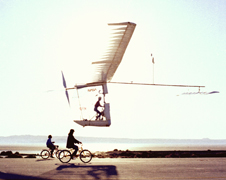March 31, 2010 Vol. 3, Issue 3
Thirty years ago, John Manke flew the Gossamer Albatross II, a 68-pound aircraft with a 71-foot wingspan.

Originally, the gossamer craft was to fly over Rogers Dry Lake Bed, but it had flooded that spring, forcing the flights to be made on a paved taxi strip near the NASA facility. Image Credit: NASA
Bicyclist Bryan Allen first flew the Gossamer Albatross across the English Channel on June 12, 1979. The Albatross was a refined version of the 1977 Gossamer Condor, which earned designer Paul MacCready the British Kremer prize of £100,000 for the world’s first man-powered flight. Allen’s aircraft, made of carbon fiber tubing and clear Mylar, had a 96-foot wingspan and weighed 70 pounds.
In 1980, NASA sponsored the testing of the Gossamer Albatross II, a slightly modified version of Bryan Allen’s aircraft. Along with AeroVironment, Inc. and Systems Technology, Inc., NASA wanted to measure the aircraft’s performance properties (e.g. lift-to-drag ratio, powered required, and propeller efficiency) and stability and control characteristics.

Video: Rollout and takeoff of the Gossamer Albatross II at Dryden Flight Research Center in the spring of 1980. Video Credit: NASA
Navy test pilot John Manke flew the Albatross II on March 7, 1980, at Dryden Flight Research Center. Manke’s Albatross II was powered by an electric motor supplied with a 28-volt rechargeable battery (roughly equivalent to 10 AA batteries), enabled him to focus on maneuvering the plane rather than pedaling. Manke, who piloted a variety of aircraft over the course of his career, said that the Albatross II was like nothing else he’d ever flown.
The data collected from the Albatross flights contributed to a better understanding of the “unusual aerodynamic, performance, stability, and control characteristics of large, lightweight aircraft that fly at low speeds.” It informed the design of future X-planes such as the X-33 and X-38.
Read the NASA report (PDF) of the Gossamer Albatross II flights.





